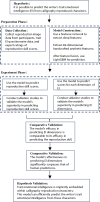Predict the writer's trait emotional intelligence from reproduced calligraphy
- PMID: 40770015
- PMCID: PMC12328608
- DOI: 10.1038/s41598-025-13318-3
Predict the writer's trait emotional intelligence from reproduced calligraphy
Abstract
Trait emotional intelligence (EI) describes an individual's ability to control their emotions. In Chinese calligraphy, there is a saying that "the character reflects the person." This raises a hypothesis: is it possible to predict a writer's trait EI from their calligraphy reproductions? To test this hypothesis, we propose a predictive method that integrates deep learning with aesthetic features of calligraphy. First, a hard pen calligraphy reproduction dataset was constructed, consisting of 48,826 reproduced characters from 191 participants, with corresponding trait EI scores and reproduction skill score ratings. A Siamese neural network was then used to extract deep feature differences between the reproduction characters and the reference characters, which were further combined with handcrafted features for regression-based predictions. Experimental results show that, using Mean Absolute Error (MAE), Mean Squared Error (MSE) and Pearson Correlation Coefficient (PCC) as evaluation metrics, this method's ability to predict the writer's trait EI from calligraphy reproductions (MAE: 0.463, MSE: 0.462, PCC: 0.730) significantly outperforms human evaluative abilities (MAE: 1.006, MSE: 1.740, PCC: 0.145), confirming that calligraphy reproductions indeed contain latent information about the writer's trait EI.
Keywords: Calligraphy psychology; Computational aesthetics; Computer assisted assessment; Psychological projection experiment; Siamese neural network; Trait EI prediction.
© 2025. The Author(s).
Conflict of interest statement
Declarations. Competing interests: The authors declare no competing interests.
Figures






Similar articles
-
Comparison of Two Modern Survival Prediction Tools, SORG-MLA and METSSS, in Patients With Symptomatic Long-bone Metastases Who Underwent Local Treatment With Surgery Followed by Radiotherapy and With Radiotherapy Alone.Clin Orthop Relat Res. 2024 Dec 1;482(12):2193-2208. doi: 10.1097/CORR.0000000000003185. Epub 2024 Jul 23. Clin Orthop Relat Res. 2024. PMID: 39051924
-
Exercise interventions and patient beliefs for people with hip, knee or hip and knee osteoarthritis: a mixed methods review.Cochrane Database Syst Rev. 2018 Apr 17;4(4):CD010842. doi: 10.1002/14651858.CD010842.pub2. Cochrane Database Syst Rev. 2018. PMID: 29664187 Free PMC article.
-
A New Measure of Quantified Social Health Is Associated With Levels of Discomfort, Capability, and Mental and General Health Among Patients Seeking Musculoskeletal Specialty Care.Clin Orthop Relat Res. 2025 Apr 1;483(4):647-663. doi: 10.1097/CORR.0000000000003394. Epub 2025 Feb 5. Clin Orthop Relat Res. 2025. PMID: 39915110
-
The effect of sample site and collection procedure on identification of SARS-CoV-2 infection.Cochrane Database Syst Rev. 2024 Dec 16;12(12):CD014780. doi: 10.1002/14651858.CD014780. Cochrane Database Syst Rev. 2024. PMID: 39679851 Free PMC article.
-
Development and Validation of a Convolutional Neural Network Model to Predict a Pathologic Fracture in the Proximal Femur Using Abdomen and Pelvis CT Images of Patients With Advanced Cancer.Clin Orthop Relat Res. 2023 Nov 1;481(11):2247-2256. doi: 10.1097/CORR.0000000000002771. Epub 2023 Aug 23. Clin Orthop Relat Res. 2023. PMID: 37615504 Free PMC article.
References
-
- Petrides, K. V. & Furnham, A. Trait emotional intelligence: Psychometric investigation with reference to established trait taxonomies. Eur. journal personality15, 425–448. 10.1002/per.416 (2001).
-
- Petrides, K. V., Pita, R. & Kokkinaki, F. The location of trait emotional intelligence in personality factor space. Br. journal psychology98, 273–289. 10.1348/000712606X120618 (2007). - PubMed
-
- Petrides, K. V. Psychometric properties of the trait emotional intelligence questionnaire (teique). In Assessing emotional intelligence: Theory, research, and applications, 85–101, 10.1007/978-0-387-88370-0_5 (Springer, 2009).
-
- Conte, J. M. A review and critique of emotional intelligence measures. J. organizational behavior26, 433–440. https://doi.org/10.1002/job.319 (2005).
MeSH terms
LinkOut - more resources
Full Text Sources

